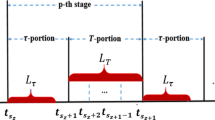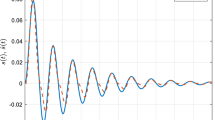Abstract
This investigation considers stability analysis and control design for nonlinear time-delay systems subject to input saturation. An anti-windup fuzzy control approach, based on fuzzy modeling of nonlinear systems, is developed to deal with the problems of stabilization of the closed-loop system and enlargement of the domain of attraction. To facilitate the designing work, the nonlinearity of saturation is first characterized by sector conditions, which provide a basis for analysis and synthesis of the anti-windup fuzzy control scheme. Then, the Lyapunov–Krasovskii delay-independent and delay-dependent functional approaches are applied to establish sufficient conditions that ensure convergence of all admissible initial states within the domain of attraction. These conditions are formulated as a convex optimization problem with constraints provided by a set of linear matrix inequalities. Finally, numeric examples are given to validate the proposed method.







Similar content being viewed by others
References
Cao YY, Frank PM (2000) Analysis and synthesis of nonlinear time-delay systems via fuzzy control approach. IEEE Trans Fuzzy Syst 8(2):200–211
Cao YY, Lin Z (2003) Robust stability analysis and fuzzy-scheduling control for nonlinear systems subject to actuator saturation. IEEE Trans Fuzzy Syst 11(1):57–67
Cao YY, Lin Z, Hu T (2002) Stability analysis of linear time-delay systems subject to input saturation. IEEE Trans Circuit Syst I 49(2):233–240
Chen B, Liu X (2005) Delay-dependent robust H ∞ control for T–S fuzzy systems with time delay. IEEE Trans Fuzzy Syst 13(4):544–556
Gomes da Silva JM Jr, Tarbouriech S (2005) Antiwindup design with guaranteed regions of stability: an LMI approach. IEEE Trans Autom Control 50(1):106–111
Guan XP, Chen CL (2004) Delay-dependent guaranteed cost control for T–S fuzzy systems with time delays. IEEE Trans Fuzzy Systems 12(2):236–249
Hale JK (1977) Theory of functional differential equations. Springer, New York
Hu T, Lin Z, Chen BM (2002) An analysis and design method for linear systems subject to actuator saturation and disturbance. Automatica 38:351–359
Kapoor N, Teel AR, Doutidis P (1998) An anti-windup design for linear systems with input saturation. Automatica (34):559–574
Kokame H, Kobayashi H, Mori T (1998) Robust H∞ performance for linear delay differential systems with time-varying uncertainties. IEEE Trans Autom Control 43(2):223–226
Mulder EF, Kothare MV, Morari M (2001) Multivariable anti-windup controller synthesis using linear matrix inequalities. Automatica 37:1407–1416
Nguyen T, Jabbari F (2000) Output feedback controllers for disturbance attenuation with actuator amplitude and rate saturation. Automatica 36:1339–1346
Park JH (2005) On design of dynamic output feedback controller for GCS of large-scale systems with delays in interconnections: LMI optimization approach. Appl Math Comput 161:423–432
Tarbouriech S, Gomes da Silva JM Jr, Garcia G (2004) Delay-dependent anti-windup strategy for linear systems with saturating inputs and delayed outputs. Int J Robust Nonlinear Control 14:665–682
Tarbouriech S, Queinnec I, Garcia C (2006) Stability region enlargement through anti-windup strategy for linear systems with dynamics restricted actuator. Int J Syst Sci 37:79–90
Tian E, Peng C (2006) Delay-dependent stability analysis and synthesis of uncertain T–S fuzzy systems with time-varying delay. Fuzzy Sets Syst 157:544–559
Trinh H, Aldeen M (1994) On the stability of linear systems with delayed perturbations. IEEE Trans Autom Control 39(9):1948–1951
Wu F, Lin Z, Zheng Q (2007) Output feedback stabilization of linear systems with actuator saturation. IEEE Trans Autom Control 52(1):122–128
Ying H (1998) General SISO Takagi-Sugeno fuzzy systems with linear rule consequent are universal approximators. IEEE Trans Fuzzy Systems 6(4):582–587
Yoneyama J (2007) Robust stability and stabilization for uncertain Takagi-Sugeno fuzzy time-delay systems. Fuzzy Sets and Systems 158:115–134
Yue D (2004) Robust stabilization of uncertain systems with unknown input dealy. Automatica (40):331–336
Yue D, Han QL (2005) Delayed feedback control of uncertain systems with time-varying input delay. Automatica (41):233–240
Acknowledgments
This work was supported by the National Science Council under grant NSC97-2221-E-150-044.
Author information
Authors and Affiliations
Corresponding author
Appendix
Appendix
Consider the following time-delay fuzzy systems:
where \( x(t) \in R^{n} ,\;x_{c} (t) \in R^{n} ,\;u(t) \in R^{P} ,\;y(t) \in R^{m} ,\;\bar{A}_{1i} ,\;\bar{A}_{2i} ,\;\bar{B}_{i} , \) and \( \bar{C}_{j} \) are system matrices of appropriate dimensions, and \( A{}_{ci}, \, B_{ci} , \) and \( C_{ci} \) are constant matrices to be determined. Define \( \xi (t) = \left[ {\begin{array}{*{20}c} {x^{T} (t)} & {x_{c}^{T} (t)} \\ \end{array} } \right]^{T} . \) The augmented system can be written as
To stabilize the system, this study applies delay-independent analysis to the design of dynamic fuzzy controller. Choose the Lyapunov–Krasovskii functional as
where P and S are positive definite matrices. Differentiating \( V(\xi ) \) with respect to time yields
Substituting Eq. 45 into Eq. 47 gives
Consequently, the stability condition can be written as
Let the partition and the inverse matrices of P be
Since \( P^{ - 1} P = I, \) it follows that \( X_{12} P_{12}^{T} = I - X_{11} P_{11} . \) Define
Then, it follows that \( PF_{1} = F_{2} \) and
Pre- and post-multiplying \( \bar{M}_{ii} \) by the matrices \( {\text{diag}}(F_{1}^{T} , \, I) \) and \( {\text{diag}}(F_{1} , \, I) \) lead to
Choose \( S = {\text{diag}}(S_{1} , \, S_{2} ). \) By proper manipulation, the condition (53) is equivalent to
where
Define the following variables:
By using Schur complement, Eq. 54 can be rewritten as
where
The same calculation is performed to deal with the inequality of \( \bar{M}_{ij} . \) That is, computing \( {\text{diag}}(F_{1}^{T} , \, I) \times \bar{M}_{ij} \times {\text{diag}}(F_{1} , \, I) \) results in
where
In the simulation, it is noticed that \( \bar{C}_{i} = \bar{C}_{j} \) and \( \bar{B}_{i} = \bar{B}_{j} . \) Due to these conditions, Eq. 59 can be modified as
where
In summary, given the solution of the LMIs (52), (57), and (61), the dynamic fuzzy controller (44) is constructed via the following procedures:
-
1.
Solve \( X_{12} \) from \( \hat{S}_{2} \) as defined in Eq. 56.
-
2.
Compute \( P_{12} \) using the relation \( X_{12} P_{12}^{T} = I - X_{11} P_{11} . \)
-
3.
Determine \( B_{ci} ,C_{ci} , \) and \( A_{ci} \) sequentially from the obtained solutions of \( X_{11} ,P_{11} ,X_{12} , \) and \( P_{12} . \)
Rights and permissions
About this article
Cite this article
Ting, CS., Liu, CS. Stabilization of nonlinear time-delay systems with input saturation via anti-windup fuzzy design. Soft Comput 15, 877–888 (2011). https://doi.org/10.1007/s00500-010-0555-5
Published:
Issue Date:
DOI: https://doi.org/10.1007/s00500-010-0555-5




